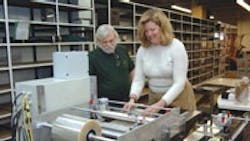The Changing Faces Of The Workplace
On factory floors, within engineering rooms and in executive offices there is a noticeable difference: the number of female faces.
"When I first started at Caterpillar I think there were three women in my area. When I left as a VP years later, there were hundreds," says Sherril West, a former vice president of Caterpillar Inc.
As of December 2006, almost 30% of the manufacturing workforce were women (4.06 million women out of 14.12 million manufacturing workers).
While that number shows progress, companies are still pushing hard to attract female employees. "Enrollment of women in our program has increased as our corporate partners sponsor more women," explains Don Rosenfeld, director of Leaders for Manufacturing, MIT's joint MBA and engineering degree program.
Once onboard, automaker DaimlerChrysler AG provides its female employees with any needed support. "Mentoring is key to how we keep our new women employees on a smooth path," explains Sandra Bouckley, a plant manager at Chrysler Group's Conner Avenue assembly plant.
| See more on women in manufacturing, including additional articles and educational resources. |
Ensuring that metrics rule rather than gender is how Amy Oesch, section manger of Freescale Semiconductor Inc.'s Oak Hill Fab facility has found success. "It doesn't matter who is performing the work. We have specific metrics that we need to meet at every point."
And like Bunzel, Oesch also benefits from a workable schedule. "I have increased my responsibilities in the company, received an additional educational degree, all the while raising my children."
But with all these strides, manufacturers still have other factors to consider when it comes to attracting women. "What fields women choose, as engineers, can be viewed as how a company directly affects society, and manufacturing companies can seem further down the loop," says Helene Finger, director of California Polytechnic State University's women's engineering program.
Autodesk's Bunzel disagrees, saying, "That's an inaccurate perception. The solutions we provide to our customers help them create innovative products that greatly benefit society. We just need to make the case that manufacturing is not the dirty, dark, dangerous place of the past. It's a clean, dynamic, multilevel process that needs innovative minds."
Attracting and holding onto female employees will continue to be a challenge for manufacturers who must sell this field to the new graduates and hold fast onto current female employees. Flexibility, training, education and recognition of a new set of working conditions will go a long way toward attracting and retaining the talent of these women.
See Also
